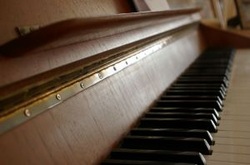
The original piano in your house is a unique musical instrument. The entire body is made up of fine quality wood. The elegant lines, intricate detailing and beautiful contour stir up unforgettable thoughts within you. But with so many years gone by, your precious piano might not be in a really good condition. Maybe it is time to consider piano refinishing.
The entire process of refinishing a piano includes the removal of the old paint, the cleaning of the surface and the application of brand new paint. The whole process can be very delicate mainly because the entire piece will have to be taken apart.
All the visible internal parts should be secured and covered. These actions must be implemented to avoid permanent damage to your piano.
The most important part of the task is centered on the hardwood body. When removing the old varnish, a special scraper should be used. In this case, a coat stripper solvent will be used for complete removal of the coating on the wood without damaging the outer lining.
The bare wood will be rinsed thoroughly using another solution. A meticulous visual inspection on the wood must be performed to check for any spots or uneven varnish coating. The scraper could also expose any breaks, scratches or damages.
In other varieties of pianos with ornate parts and legs, removing the original coat can be challenging. The curves and designs will require special care to avoid more damage, break or marks on the designs.
Upon removal of the wood coating, three runs of sand shall be applied. The rough sandpaper number 100 would be used to make the outer lining smooth and clean out the remaining solvent. This process would even out the surface right after filling up the pores and minor cracks. It will be followed by the number 120 to help polish the hardwood. Finally, the number 260 shall be used to attain the ideal smoothness of the wood.
To get the ideal depth of its natural wooden color, coats of stain must be used to restore the wooden feature or the necessary color.
Once the pore-filling, sanding and staining process are all completed, you may now proceed to piano refinishing. The most typical options to apply are shellac, nitrocellulose coating, and polyurethane. In applying lacquer, a number of coats are necessary, and it has to undergo the whole process of sanding between every coating.
The last lacquer covering can be applied, gradually getting thinner after every application. This would guarantee that your piano refinishing looks perfect and your precious instrument will continue to last for many more years to come.
The entire process of refinishing a piano includes the removal of the old paint, the cleaning of the surface and the application of brand new paint. The whole process can be very delicate mainly because the entire piece will have to be taken apart.
All the visible internal parts should be secured and covered. These actions must be implemented to avoid permanent damage to your piano.
The most important part of the task is centered on the hardwood body. When removing the old varnish, a special scraper should be used. In this case, a coat stripper solvent will be used for complete removal of the coating on the wood without damaging the outer lining.
The bare wood will be rinsed thoroughly using another solution. A meticulous visual inspection on the wood must be performed to check for any spots or uneven varnish coating. The scraper could also expose any breaks, scratches or damages.
In other varieties of pianos with ornate parts and legs, removing the original coat can be challenging. The curves and designs will require special care to avoid more damage, break or marks on the designs.
Upon removal of the wood coating, three runs of sand shall be applied. The rough sandpaper number 100 would be used to make the outer lining smooth and clean out the remaining solvent. This process would even out the surface right after filling up the pores and minor cracks. It will be followed by the number 120 to help polish the hardwood. Finally, the number 260 shall be used to attain the ideal smoothness of the wood.
To get the ideal depth of its natural wooden color, coats of stain must be used to restore the wooden feature or the necessary color.
Once the pore-filling, sanding and staining process are all completed, you may now proceed to piano refinishing. The most typical options to apply are shellac, nitrocellulose coating, and polyurethane. In applying lacquer, a number of coats are necessary, and it has to undergo the whole process of sanding between every coating.
The last lacquer covering can be applied, gradually getting thinner after every application. This would guarantee that your piano refinishing looks perfect and your precious instrument will continue to last for many more years to come.
